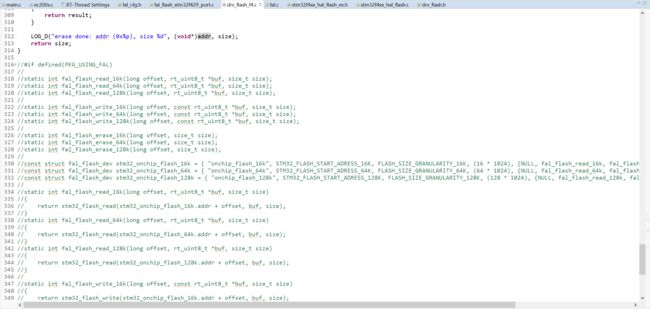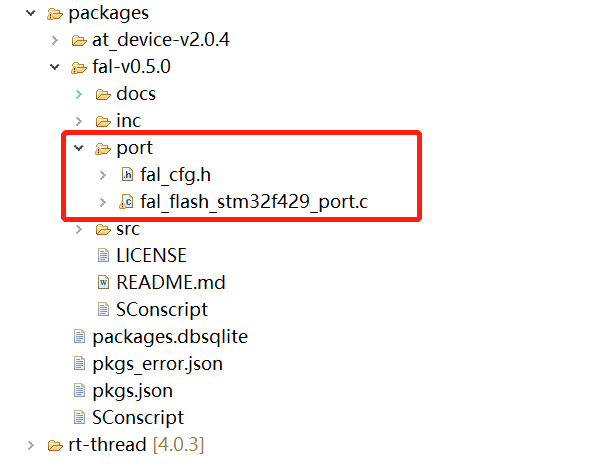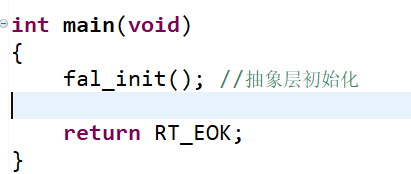RT-Thread Studio STM32F249BIT6片内FLASH移植FAL记录
RT-Thread Studio STM32F249BIT6移植FAL记录
刚好需要使用到操作内部flash,发现FAL这个很不错,移植过程遇到一些小bug,故此记录一下。
我使用的是STM32F429BIT6 内部有2M的flash和网上大部分人不一样。
1.先增加软件包
[外链图片转存失败,源站可能有防盗链机制,建议将图片保存下来直接上传(img-42yEQLN0-1641811651714)(https://os.zhengshijian.com//img/image-20220110183319490.png)]
[外链图片转存失败,源站可能有防盗链机制,建议将图片保存下来直接上传(img-BZSFjp4G-1641811651716)(https://os.zhengshijian.com//img/image-20220110183309722.png)]
在rtt studio没找到flash的地方,直接再board.h中增加宏来打开

2.增加port文件
下面是这两个文件的代码
h文件
/*
* File : fal_cfg.h
* This file is part of FAL (Flash Abstraction Layer) package
* COPYRIGHT (C) 2006 - 2018, RT-Thread Development Team
*
* This program is free software; you can redistribute it and/or modify
* it under the terms of the GNU General Public License as published by
* the Free Software Foundation; either version 2 of the License, or
* (at your option) any later version.
*
* This program is distributed in the hope that it will be useful,
* but WITHOUT ANY WARRANTY; without even the implied warranty of
* MERCHANTABILITY or FITNESS FOR A PARTICULAR PURPOSE. See the
* GNU General Public License for more details.
*
* You should have received a copy of the GNU General Public License along
* with this program; if not, write to the Free Software Foundation, Inc.,
* 51 Franklin Street, Fifth Floor, Boston, MA 02110-1301 USA.
*
* Change Logs:
* Date Author Notes
* 2018-05-17 armink the first version
*/
#ifndef _FAL_CFG_H_
#define _FAL_CFG_H_
#include c文件
/*
* File : fal_flash_stm32f4_port.c
* This file is part of FAL (Flash Abstraction Layer) package
* COPYRIGHT (C) 2006 - 2018, RT-Thread Development Team
*
* This program is free software; you can redistribute it and/or modify
* it under the terms of the GNU General Public License as published by
* the Free Software Foundation; either version 2 of the License, or
* (at your option) any later version.
*
* This program is distributed in the hope that it will be useful,
* but WITHOUT ANY WARRANTY; without even the implied warranty of
* MERCHANTABILITY or FITNESS FOR A PARTICULAR PURPOSE. See the
* GNU General Public License for more details.
*
* You should have received a copy of the GNU General Public License along
* with this program; if not, write to the Free Software Foundation, Inc.,
* 51 Franklin Street, Fifth Floor, Boston, MA 02110-1301 USA.
*
* Change Logs:
* Date Author Notes
* 2018-01-26 armink the first version
*/
#include
#include
#define DBG_TAG "fal_flash_port"
#define DBG_LVL DBG_LOG
#include
/* base address of the flash sectors */
#define ADDR_FLASH_SECTOR_0 ((uint32_t)0x08000000) /* Base address of Sector 0, 16 K bytes */
#define ADDR_FLASH_SECTOR_1 ((uint32_t)0x08004000) /* Base address of Sector 1, 16 K bytes */
#define ADDR_FLASH_SECTOR_2 ((uint32_t)0x08008000) /* Base address of Sector 2, 16 K bytes */
#define ADDR_FLASH_SECTOR_3 ((uint32_t)0x0800C000) /* Base address of Sector 3, 16 K bytes */
#define ADDR_FLASH_SECTOR_4 ((uint32_t)0x08010000) /* Base address of Sector 4, 64 K bytes */
#define ADDR_FLASH_SECTOR_5 ((uint32_t)0x08020000) /* Base address of Sector 5, 128 K bytes */
#define ADDR_FLASH_SECTOR_6 ((uint32_t)0x08040000) /* Base address of Sector 6, 128 K bytes */
#define ADDR_FLASH_SECTOR_7 ((uint32_t)0x08060000) /* Base address of Sector 7, 128 K bytes */
#define ADDR_FLASH_SECTOR_8 ((uint32_t)0x08080000) /* Base address of Sector 8, 128 K bytes */
#define ADDR_FLASH_SECTOR_9 ((uint32_t)0x080A0000) /* Base address of Sector 9, 128 K bytes */
#define ADDR_FLASH_SECTOR_10 ((uint32_t)0x080C0000) /* Base address of Sector 10, 128 K bytes */
#define ADDR_FLASH_SECTOR_11 ((uint32_t)0x080E0000) /* Base address of Sector 11, 128 K bytes */
#define ADDR_FLASH_SECTOR_12 ((uint32_t)0x08100000) /* Base address of Sector 0, 16 K bytes */
#define ADDR_FLASH_SECTOR_13 ((uint32_t)0x08104000) /* Base address of Sector 1, 16 K bytes */
#define ADDR_FLASH_SECTOR_14 ((uint32_t)0x08108000) /* Base address of Sector 2, 16 K bytes */
#define ADDR_FLASH_SECTOR_15 ((uint32_t)0x0810C000) /* Base address of Sector 3, 16 K bytes */
#define ADDR_FLASH_SECTOR_16 ((uint32_t)0x08110000) /* Base address of Sector 4, 64 K bytes */
#define ADDR_FLASH_SECTOR_17 ((uint32_t)0x08120000) /* Base address of Sector 5, 128 K bytes */
#define ADDR_FLASH_SECTOR_18 ((uint32_t)0x08140000) /* Base address of Sector 6, 128 K bytes */
#define ADDR_FLASH_SECTOR_19 ((uint32_t)0x08160000) /* Base address of Sector 7, 128 K bytes */
#define ADDR_FLASH_SECTOR_20 ((uint32_t)0x08180000) /* Base address of Sector 8, 128 K bytes */
#define ADDR_FLASH_SECTOR_21 ((uint32_t)0x081A0000) /* Base address of Sector 9, 128 K bytes */
#define ADDR_FLASH_SECTOR_22 ((uint32_t)0x081C0000) /* Base address of Sector 10, 128 K bytes */
#define ADDR_FLASH_SECTOR_23 ((uint32_t)0x081E0000) /* Base address of Sector 11, 128 K bytes */
/**
* Get the sector of a given address
*
* @param address flash address
*
* @return The sector of a given address
*/
static uint32_t stm32_get_sector(uint32_t address)
{
uint32_t sector = 0;
if ((address < ADDR_FLASH_SECTOR_1) && (address >= ADDR_FLASH_SECTOR_0))
{
sector = FLASH_SECTOR_0;
}
else if ((address < ADDR_FLASH_SECTOR_2) && (address >= ADDR_FLASH_SECTOR_1))
{
sector = FLASH_SECTOR_1;
}
else if ((address < ADDR_FLASH_SECTOR_3) && (address >= ADDR_FLASH_SECTOR_2))
{
sector = FLASH_SECTOR_2;
}
else if ((address < ADDR_FLASH_SECTOR_4) && (address >= ADDR_FLASH_SECTOR_3))
{
sector = FLASH_SECTOR_3;
}
else if ((address < ADDR_FLASH_SECTOR_5) && (address >= ADDR_FLASH_SECTOR_4))
{
sector = FLASH_SECTOR_4;
}
else if ((address < ADDR_FLASH_SECTOR_6) && (address >= ADDR_FLASH_SECTOR_5))
{
sector = FLASH_SECTOR_5;
}
else if ((address < ADDR_FLASH_SECTOR_7) && (address >= ADDR_FLASH_SECTOR_6))
{
sector = FLASH_SECTOR_6;
}
else if ((address < ADDR_FLASH_SECTOR_8) && (address >= ADDR_FLASH_SECTOR_7))
{
sector = FLASH_SECTOR_7;
}
else if ((address < ADDR_FLASH_SECTOR_9) && (address >= ADDR_FLASH_SECTOR_8))
{
sector = FLASH_SECTOR_8;
}
else if ((address < ADDR_FLASH_SECTOR_10) && (address >= ADDR_FLASH_SECTOR_9))
{
sector = FLASH_SECTOR_9;
}
else if ((address < ADDR_FLASH_SECTOR_11) && (address >= ADDR_FLASH_SECTOR_10))
{
sector = FLASH_SECTOR_10;
}else if ((address < ADDR_FLASH_SECTOR_12) && (address >= ADDR_FLASH_SECTOR_11)){
sector = FLASH_SECTOR_11;
}
else if ((address < ADDR_FLASH_SECTOR_13) && (address >= ADDR_FLASH_SECTOR_12))
{
sector = FLASH_SECTOR_12;
}
else if ((address < ADDR_FLASH_SECTOR_14) && (address >= ADDR_FLASH_SECTOR_13))
{
sector = FLASH_SECTOR_13;
}
else if ((address < ADDR_FLASH_SECTOR_15) && (address >= ADDR_FLASH_SECTOR_14))
{
sector = FLASH_SECTOR_14;
}
else if ((address < ADDR_FLASH_SECTOR_16) && (address >= ADDR_FLASH_SECTOR_15))
{
sector = FLASH_SECTOR_15;
}
else if ((address < ADDR_FLASH_SECTOR_17) && (address >= ADDR_FLASH_SECTOR_16))
{
sector = FLASH_SECTOR_16;
}
else if ((address < ADDR_FLASH_SECTOR_18) && (address >= ADDR_FLASH_SECTOR_17))
{
sector = FLASH_SECTOR_17;
}
else if ((address < ADDR_FLASH_SECTOR_19) && (address >= ADDR_FLASH_SECTOR_18))
{
sector = FLASH_SECTOR_18;
}
else if ((address < ADDR_FLASH_SECTOR_20) && (address >= ADDR_FLASH_SECTOR_19))
{
sector = FLASH_SECTOR_19;
}
else if ((address < ADDR_FLASH_SECTOR_21) && (address >= ADDR_FLASH_SECTOR_20))
{
sector = FLASH_SECTOR_20;
}else if ((address < ADDR_FLASH_SECTOR_22) && (address >= ADDR_FLASH_SECTOR_21))
{
sector = FLASH_SECTOR_21;
}
else if ((address < ADDR_FLASH_SECTOR_23) && (address >= ADDR_FLASH_SECTOR_22))
{
sector = FLASH_SECTOR_22;
}else {
sector = FLASH_SECTOR_23;
}
return sector;
}
/**
* Get the sector size
*
* @param sector sector
*
* @return sector size
*/
static uint32_t stm32_get_sector_size(uint32_t sector) {
assert(IS_FLASH_SECTOR(sector));
switch (sector) {
case FLASH_SECTOR_0: return 16 * 1024;
case FLASH_SECTOR_1: return 16 * 1024;
case FLASH_SECTOR_2: return 16 * 1024;
case FLASH_SECTOR_3: return 16 * 1024;
case FLASH_SECTOR_4: return 64 * 1024;
case FLASH_SECTOR_5: return 128 * 1024;
case FLASH_SECTOR_6: return 128 * 1024;
case FLASH_SECTOR_7: return 128 * 1024;
case FLASH_SECTOR_8: return 128 * 1024;
case FLASH_SECTOR_9: return 128 * 1024;
case FLASH_SECTOR_10: return 128 * 1024;
case FLASH_SECTOR_11: return 128 * 1024;
case FLASH_SECTOR_12: return 16 * 1024;
case FLASH_SECTOR_13: return 16 * 1024;
case FLASH_SECTOR_14: return 16 * 1024;
case FLASH_SECTOR_15: return 16 * 1024;
case FLASH_SECTOR_16: return 64 * 1024;
case FLASH_SECTOR_17: return 128 * 1024;
case FLASH_SECTOR_18: return 128 * 1024;
case FLASH_SECTOR_19: return 128 * 1024;
case FLASH_SECTOR_20: return 128 * 1024;
case FLASH_SECTOR_21: return 128 * 1024;
case FLASH_SECTOR_22: return 128 * 1024;
case FLASH_SECTOR_23: return 128 * 1024;
default : return 128 * 1024;
}
}
static int init(void)
{
/* do nothing now */
}
static int read(long offset, uint8_t *buf, size_t size)
{
size_t i;
uint32_t addr = stm32f4_onchip_flash.addr + offset;
if ((addr + size) > STM32_FLASH_END_ADDRESS)
{
LOG_E("read outrange flash size! addr is (0x%p)", (void*)(addr + size));
return -1;
}
for (i = 0; i < size; i++, addr++, buf++)
{
*buf = *(uint8_t *) addr;
}
return size;
}
static int write(long offset, const uint8_t *buf, size_t size)
{
size_t i;
rt_err_t result = RT_EOK;
uint32_t read_data;
uint32_t addr = stm32f4_onchip_flash.addr + offset;
uint32_t end_addr = addr + size;
if ((end_addr) > STM32_FLASH_END_ADDRESS)
{
LOG_E("write outrange flash size! addr is (0x%p)", (void*)(addr + size));
return -RT_EINVAL;
}
if (size < 1)
{
return -RT_EINVAL;
}
HAL_FLASH_Unlock();
__HAL_FLASH_CLEAR_FLAG(FLASH_FLAG_EOP | FLASH_FLAG_OPERR | FLASH_FLAG_WRPERR | FLASH_FLAG_PGAERR | FLASH_FLAG_PGPERR | FLASH_FLAG_PGSERR);
for (size_t i = 0; i < size; i++, addr++, buf++)
{
/* write data to flash */
if (HAL_FLASH_Program(FLASH_TYPEPROGRAM_BYTE, addr, (rt_uint64_t)(*buf)) == HAL_OK)
{
if (*(rt_uint8_t *)addr != *buf)
{
result = -RT_ERROR;
break;
}
}
else
{
result = -RT_ERROR;
break;
}
}
HAL_FLASH_Lock();
if (result != RT_EOK)
{
return result;
}
return size;
}
static int erase(long offset, size_t size)
{
uint32_t addr = stm32f4_onchip_flash.addr + offset;
rt_err_t result = RT_EOK;
rt_uint32_t FirstSector = 0, NbOfSectors = 0;
rt_uint32_t SECTORError = 0;
if ((addr + size) > STM32_FLASH_END_ADDRESS)
{
LOG_E("ERROR: erase outrange flash size! addr is (0x%p)\n", (void*)(addr + size));
return -RT_EINVAL;
}
/*Variable used for Erase procedure*/
FLASH_EraseInitTypeDef EraseInitStruct;
/* Unlock the Flash to enable the flash control register access */
HAL_FLASH_Unlock();
__HAL_FLASH_CLEAR_FLAG(FLASH_FLAG_EOP | FLASH_FLAG_OPERR | FLASH_FLAG_WRPERR | FLASH_FLAG_PGAERR | FLASH_FLAG_PGPERR | FLASH_FLAG_PGSERR);
/* Get the 1st sector to erase */
FirstSector = stm32_get_sector(addr);
/* Get the number of sector to erase from 1st sector*/
NbOfSectors = stm32_get_sector(addr + size - 1) - FirstSector + 1;
/* Fill EraseInit structure*/
EraseInitStruct.TypeErase = FLASH_TYPEERASE_SECTORS;
EraseInitStruct.VoltageRange = FLASH_VOLTAGE_RANGE_3;
EraseInitStruct.Sector = FirstSector;
EraseInitStruct.NbSectors = NbOfSectors;
if (HAL_FLASHEx_Erase(&EraseInitStruct, (uint32_t *)&SECTORError) != HAL_OK)
{
result = -RT_ERROR;
goto __exit;
}
__exit:
HAL_FLASH_Lock();
if (result != RT_EOK)
{
return result;
}
LOG_D("erase done: addr (0x%p), size %d", (void*)addr, size);
return size;
}
static int stm32_flash_init(void)
{
/* doing nothing now */
}
const struct fal_flash_dev stm32f4_onchip_flash =
{
.name = "stm32f4_onchip",
.addr = 0x08000000, // Flash start address
.len = 2*1024*1024, //stm32f429bit6 2M Flash
.blk_size = 128*1024, //largest sector size
//.ops = {stm32_flash_init, stm32_flash_read, stm32_flash_write, stm32_flash_erase},
.ops = {stm32_flash_init, read, write, erase},
.write_gran = 8
};
3.命令行测试
首先需要先在主函数初始化
下面使用的是msh测试,没有代码测试。
注意点:
- 分区表的flash设备名要和fal_flash_dev中定义的名称一致
- 我没有用rtthread里的drv_flash_f4.c的函数,最开始用这个出错了,被我改掉了。
 他这里用的是3个dev,每个dev地址还要自己配置,我这个是2个bank的flash,跟普通的不一样,所以得自己写。应该就是地址出错了,所以用他的flash读写擦函数出错了。
他这里用的是3个dev,每个dev地址还要自己配置,我这个是2个bank的flash,跟普通的不一样,所以得自己写。应该就是地址出错了,所以用他的flash读写擦函数出错了。
很多教程都是多个dev设备,我这里直接用了单一个dev,然后多个分区表基于这个dev。
[外链图片转存失败,源站可能有防盗链机制,建议将图片保存下来直接上传(img-kMbGBpbc-1641811651717)(https://os.zhengshijian.com//img/image-20220110183842189.png)]
好了,FAL弄好了,统一了操作接口,OTA就好弄了,后面如果改到外部SPI FLASH也极其方便,现在这个2M Flash够我用,所以也就不弄外部SPI FLASH了。


